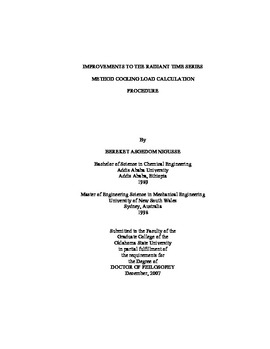| dc.contributor.advisor | Spitler, Jeffrey D. | |
| dc.contributor.author | Nigusse, Bereket Asgedom | |
| dc.date.accessioned | 2013-12-10T18:05:21Z | |
| dc.date.available | 2013-12-10T18:05:21Z | |
| dc.date.issued | 2007-12 | |
| dc.identifier.uri | https://hdl.handle.net/11244/7813 | |
| dc.description.abstract | Scope and Method of Study: The objective of the study was improvement of the Radiant Time Series Method (RTSM) cooling load calculation procedure. A series of investigations were carried out, including: improvements to peak cooling load prediction performance, development of a simplified procedure for Radiant Time Factor (RTF) generation, adaptation of the fenestration sub-model to be compatible with currently available manufacturer's data, establishing appropriate radiative fractions for all heat gain types. The simplified RTF generation procedure facilitates implementation in a range of computing environments. Furthermore, an approximate one-dimensional dynamic model for thermal bridges has been investigated and validated against both experimental results and detailed computational results. | |
| dc.description.abstract | Findings and Conclusions: The Radiant Time Series Method was modified by introducing a dimensionless loss conductance that is readily calculable from the zone geometry and surface characteristic. Along with the revised fenestration sub-model, newly-recommended radiative fractions, and simplified RTF generation procedure, the RTSM performance was validated against the reference method, the heat balance method (HBM) with a large parametric study. The parametric study compared peak cooling loads determined with the improved RTSM procedure to those determined with the HBM for a wide range of building design parameters, for which all combinations formed 2,867,200 different zones. Use of the dimensionless loss conductance caused the maximum overprediction to go from 37% to 18%. | |
| dc.description.abstract | Several additional simplifications were made to facilitate implementation in a range of computing environments. These simplifications included development of a one-dimensional finite volume numerical procedure for generating periodic response factors. This reduced the number of lines of source-code required with the previous state-space method from 2000 to 500 in Fortran 90. In a computing environment with embedded matrix algebra, such as SCILAB, the number of lines of source-code can be further reduced to 150. The new formulation of the RTF generation procedure allows very compact implementation (150 lines of source code, compared to the original procedure, implemented in approximately 4000 lines of Fortran 90 source code) in computing. | |
| dc.description.abstract | The approximate one-dimensional dynamic model of thermal bridges has been validated against published experimental results and also against numerical results generated with a 2D finite volume program. The approximate model can predict peak heat gains within ±2.6% of the experimental measurements, provided accurate steady state thermal resistances are used. | |
| dc.format | application/pdf | |
| dc.language | en_US | |
| dc.rights | Copyright is held by the author who has granted the Oklahoma State University Library the non-exclusive right to share this material in its institutional repository. Contact Digital Library Services at lib-dls@okstate.edu or 405-744-9161 for the permission policy on the use, reproduction or distribution of this material. | |
| dc.title | Improvements to the radiant time series method cooling load calculation procedure | |
| dc.contributor.committeeMember | Fisher, Daniel E. | |
| dc.contributor.committeeMember | Cremaschi, Lorenzo | |
| dc.contributor.committeeMember | Noell, Alan | |
| osu.filename | Nigusse_okstate_0664D_10587.pdf | |
| osu.accesstype | Open Access | |
| dc.type.genre | Dissertation | |
| dc.type.material | Text | |
| dc.subject.keywords | cooling load | |
| dc.subject.keywords | fenestration model | |
| dc.subject.keywords | radiant time series method | |
| dc.subject.keywords | thermal bridges | |
| thesis.degree.discipline | Mechanical and Aerospace Engineering | |
| thesis.degree.grantor | Oklahoma State University | |
